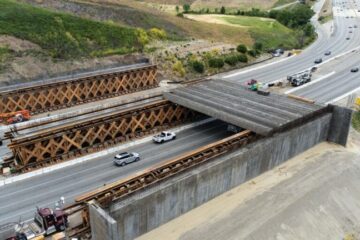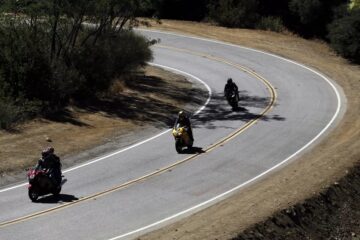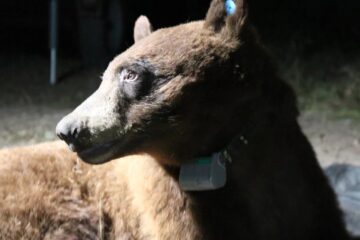Flap over Lynn Ranch flag persists
Posting of U.S. flags on public land causes heated debate
Source of this article: The Thousand Oaks Acorn, September 15, 2011
By Anna Bitong
An American flag once fluttered over a ridge near Lynn Ranch. It flew in the same spot for at least a dozen years, maybe longer, local residents say.The waving tribute was a symbol of patriotism to some. To others, it was an unnatural obstruction.
On July 4, the flag was stolen. Then someone carved a message to military veterans on the bare flag post: “To the veterans thanks.” By July 21, vandals had pulverized the red, white and blue stump to a pile of rubble. It is unclear who constructed the post. It is also unclear who destroyed it.
Tony DeFranco of Lynn Ranch sent the Acorn photos of the base before and after it was damaged. After they were published Aug. 4, DeFranco received numerous responses from people offering to help him construct a new post.
![2p1[1]](http://www.venturacountytrails.org/WP/wp-content/uploads/2011/11/2p11.jpg)
STARS & STRIPES—Thousand Oaks residents Stacy and Tony DeFranco ride their horses up to a ridge to see the flag, which has since been removed. The land is managed by the Conejo Open Space Conservation Agency, which forbids the placement or storage of any structure on the grounds.
According to the Conejo Open Space Conservation Agency, which protects the open space where the flag stood, it shouldn’t have been there in the first place.
COSCA, created in 1977, is an alliance between the City of Thousand Oaks and CRPD that enforces rules aimed at preserving open space in a natural, undeveloped state. It owns or manages about 11,300 acres of open space and more than 140 miles of trails.
The agency prohibits encroach- ment on open space, which includes cons truction, placement or storage of any structure or facility on the public grounds.
Since the flag post was demolished, no one has come to sweep away what remains, DeFranco said.
“The destroyed remnants are still there. Why doesn’t (COSCA) clean it up if it’s not supposed to be there? I’m disgusted every time I see it,” he said.
DeFranco thinks the rules should be changed to allow the flag to stay.
“It’s cut and dry to me. This flag has been there for years and the open space committee never took it down,” he said.
But Matt Kouba, CRPD superintendent, remembered taking down flags from the same base numerous times when he was a park ranger more than a decade ago, only to see another one appear in its place.
“It became a contentious situation,” Kouba said. “There were years at a time when a flag was not up at all.”
Indeed, the monument had a tumultuous past.
Despite COSCA’s ordinance, rule breakers fortified the flag base over time.
“More recently, in the last few years, the structure had become more significant,” Kouba said.
“People had put in a concrete footing. They armored the pole with barbed wire and grease because other people were taking the flag down.”
Kouba said public response to the issue has varied from support of U.S. flags on public land to criticism of how the flags are displayed on open space.
“Some (military) veterans say it’s disrespectful to the flags because there are no lights,” he said.
Patrick Hehir, Thousand Oaks assistant city attorney, said there are federal guidelines for displaying an American flag.
“There is a U.S. flag code that many people are not aware of,” Hehir said, one of which requires illuminating the flag at night. However, the government does not enforce its recommendations or list penalties for noncompliance.
Hehir said that from a legal perspective, putting up a flag in a public area may be considered a statement that cannot be permitted exclusively.
To support his point, the attorney referenced a 2002 court case in which the California Depart- ment of Trans- portation was sued by two individuals for taking down their anti-war banners but allowing U.S. flags to fly from a freeway overpass in Santa Cruz after the terrorist attacks of Sept. 11, 2001.
According to the U.S. Court of Appeals, ninth circuit, “It is the potency of the flag’s message that makes Caltrans reluctant to remove it from California’s highways. In light of recent world events, that reluctance is laudable; however, the policy derived from it is not.”
David Mathews, a longtime volunteer with the Nature Conservancy, said there are plenty of alternatives to posting flags on open space.
“You can fly a flag in front of your house. There are many businesses that fly flags. I have no objections to any of those things,” Mathews said. “I’m not against flying the American flag. It’s a question of where.
“The idea is to have a natural area where people can go without being confronted with signs and billboards,” said Mathews, a Thousand Oaks resident.
Kouba agreed.
“Leave the smallest footprint that you can on open space,” he said. “So much of the habitat is sensitive.
“We want it to be for everyone in perpetuity. The goal is to keep open space close to the way it is now and the way it was in the past.”
But for some, America’s national symbol was part of that past. For DeFranco, its absence still stings.
“It’s a matter of pride,” DeFranco said. “If you look at what has gone on back to the Vietnam War and 9/11, what is wrong with putting up your country’s flag? They are taking rules trying to please everyone too far.”


